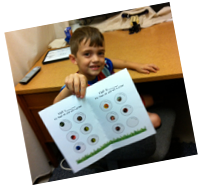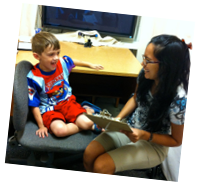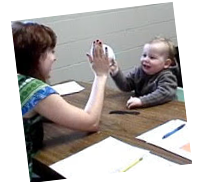Mechanisms of language learning
We have been studying how basic cognitive skills contribute to variation in children’s language learning. For instance, we have examined situations where new vocabulary is taught explicitly, and children’s ability to use social vs. non-social cues to learn these new words, and to retain them over time. We have also investigated implicit learning situations: whether children are able to pick up on patterns that are not taught directly (i.e., procedural learning of a visual sequence), and how this relates to their language skills. In other studies we have examined memory for speech sounds, through tasks where children are asked to repeat nonsense or “non-words”, and how this may relate to their ability to learn language, and how it may differ across populations. Together these findings give insight into multiple sources of variability in language learning that arise from basic cognitive mechanisms.



Publications
Journal Articles
- Bang, J. Y., Sharda, M., & Nadig, A. S. (2020). Towards greater transparency in neurodevelopmental disorders research: use of a proposed workflow and propensity scores to facilitate selection of matched groups. Journal of Neurodevelopmental Disorders, 12(1), 1-15. https://doi.org/10.1186/s11689-020-09321-6
- Bang, J. Y., & Nadig, A. (2020). An investigation of word learning in the presence of gaze: Evidence from school-age children with typical development or Autism Spectrum Disorder. Cognitive Development, 54, 100847. https://doi.org/10.1016/j.cogdev.2020.100847
- Eberhardt, M. & Nadig, A. (2018). Reduced sensitivity to context in language comprehension: A characteristic of Autism Spectrum Disorders or of poor structural language abilities? Research in Developmental Disabilities, 72, 284-296. http://dx.doi.org/10.1016/j.ridd.2016.01.017
- Nadig, A. & Mulligan, A. (2017). Intact non-word repetition and similar error patterns in language-matched children with autism spectrum disorders: A pilot study. Journal of Communication Disorders, 66, 13-21. https://doi.org/10.1016/j.jcomdis.2017.03.003
- Bani Hani, H., Gonzalez-Barrero, A. & Nadig, A. (2013). Children’s referential understanding of novel words and parent labelling behaviours: similarities across children with and without autism spectrum disorders. Journal of Child Language, 40 (5), 971-1002. https://doi.org/10.1017/S0305000912000426
- Bourguignon, N., Nadig, A. & Valois, D. (2012). The Biolinguistics of Autism: Emergent Perspectives. Biolinguistics, 6 (2), 124-165. http://biolinguistics.eu/index.php/biolinguistics/article/view/234
- Vivanti, G., Nadig, A., Ozonoff, S., & Rogers, S.J. (2008). What do children with autism attend to during imitation tasks? Journal of Experimental Child Psychology, Special issue on Imitation in Autism, 101, 186-205.
- Nadig, A., Ozonoff, S., Singh, L., Young, G., & Rogers, S. J. (2007). Do 6-month-old infants at risk for autism display an infant-directed speech preference? In H. Caunt-Nulton, S. Kulatikake, & I. Woo (Eds.), Proceedings of the 31st Annual Boston University Conference on Language Development (451-461). Somerville, MA: Cascadilla Press.
Selected Conference Presentations
- Goad, H., Li, F., Gonzalez Barrero, A.M. & Nadig, A. (2019, May). Phonological Factors Underlying Performance on a Multi-Lingual Non-Word Repetition Task. Poster presented at the annual meeting of the International Society for Autism Research, Montreal, Canada.
- Li, F., Gonzalez Barrero, A.M. Goad, H., & Nadig, A. (2019, May). Evaluation of a Novel Non-Word Repetition Test As a Clinical Marker for Language Impairment in Multilingually-Exposed Children with ASD. Poster presented at the annual meeting of the International Society for Autism Research, Montreal, Canada.
